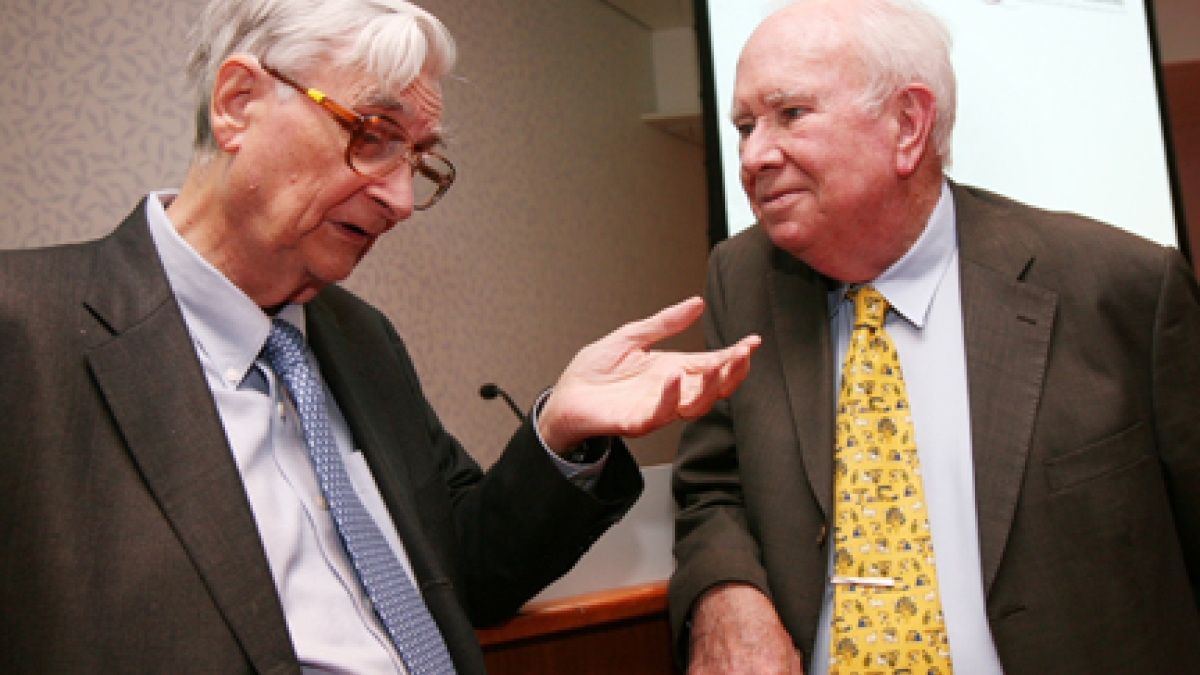Linnaean Legacy Award winners call for boost in species exploration

Biodiversity crusaders Peter H. Raven and Edward O. Wilson received Linnaean Legacy Awards Nov. 6 for their extraordinary contributions to taxonomy and the exploration and classification of species. The pair of internationally known scientists used the occasion to call on individuals and taxonomists alike to do their part to sustain the biodiversity of Earth, which includes identifying millions of species before they become extinct.
The 2010 Linnaean Legacy Awards were given by the International Institute for Species Exploration at Arizona State University and the Linnean Society of London during a presentation and public lectures at the New York Academy of Sciences.
“The award ceremony tonight kicks off what I believe is a groundbreaking event. Over the next couple of days, about 30 scientists, engineers and scholars from around the world are gathering in New York for an extraordinary envisioning exercise to determine what it would take to mount an unprecedented mission to explore, discover, describe and classify all of Earth’s species,” said Quentin Wheeler, an entomologist and director of ASUs International Institute for Species Exploration.
By most estimates, there are about 1.9 million known species, or, at most, 20 percent of Earth’s species, said Wheeler, who also is a university vice president and dean of the College of Liberal Arts and Sciences at ASU.
Some 30 percent of Earth’s species will become extinct this century, “changing the entire character of life on Earth,” noted Raven, President Emeritus of the Missouri Botanical Garden.
“We need to learn as much as we can, in selected ways about certain groups and interactions of species, and the way that ecosystems and sustainability are really formed,” Raven said.
“It’s a huge task…. We need to tell people about it, learn about it, bring up knowledgeable children who are fascinated with nature and who may then become discriminating adults able to contribute well to the preservation of the world of the future,” said Raven in his lecture titled “Which Gaps Can We Fill, What Can We Save?”
Wilson, a University Research Professor Emeritus at Harvard, said he noticed severe changes in the environment during the 1950s and 1960s when he was doing field work in the tropics. Instead of speaking up, however, he admitted to staying focused on his research, assuming that “wonderful organizations around the world would take care of the problems.” An article he read by Raven, “something about a knockdown, drag out fight,” he quipped, inspired him to begin speaking out about the biodiversity crisis.
“Finally, it became apparent to me that we cannot sit by our microscopes and in museums without speaking out,” said Wilson in his lecture titled “Exploring a Little Known World in Order to Save It.”
Wilson acknowledged that in the 21st century the world is turning green (“at least a pastel green”) and that there’s been attention and heavy emphasis on the physical environment — climate change, pollution, decline of fresh water.
Yet, “we are a biological species, in a biological world,” he said, alluding to what he modestly referred to as “Wilson’s Law:” If you change the living environment you will automatically also save the physical environment. But, if you save only the physical environment, you will ultimately lose them both.”
The challenge, according to Wilson, “is to find a way to save our quality of life, while stamping down a small ecological footprint on the Earth.”
Wilson fervently encouraged the gathered scientists to “utilize the digital revolution as fully and aggressively as possible to accumulate knowledge of known species and advance exploration of that which is unknown, and, evaluate it.”
Wheeler, the organizer of the corresponding scientific conference “Sustain What? Mission to Explore Earth’s Species and Conserve Biodiversity” said there were several reasons to fully explore and document the results of 4 billion years of evolution.
“Among them is so curious humans who come after us will have the opportunity to continue to explore and come to wonder and understand evolution,” Wheeler said. “But also to establish a baseline understanding and to map the species of the biosphere so that humanity has the opportunity to detect and monitor the changes already afoot, whether due to climate change or degradation of habitats or biodiversity loss or the introduction of non-native species.”
The Linnaean Legacy Award presented to Raven and Wilson is named for the 18th century Swedish natural historian Carolus Linnaeus who developed the binomial naming system of plants and animals that provides the fundamental framework for knowledge of the biota of the Earth, said Sandra Knapp, merit researcher at the Natural History Museum in London and the botanical secretary and vice president of the Linnean Society of London.
Knapp and Wheeler presented the awards to Raven and Wilson before an audience of some 200 individuals, which included high school students, science teachers, graduate students and a past Linnaean Legacy Award recipient, Norman Platnick, an arachnologist and curator emeritus in the Division of Invertebrate Zoology at the American Museum of Natural History in New York. The event was held at the New York Academy of Sciences as part of their science education initiative, chaired by Fernand Brunschwig, professor of physics and science education at Empire State College.
The International Institute for Species Exploration is a pioneering research center established in 2007 at Arizona State University to advance “cybertaxonomy,” a fusion of taxonomy with computer science and engineering. More information is at http://species.asu.edu.